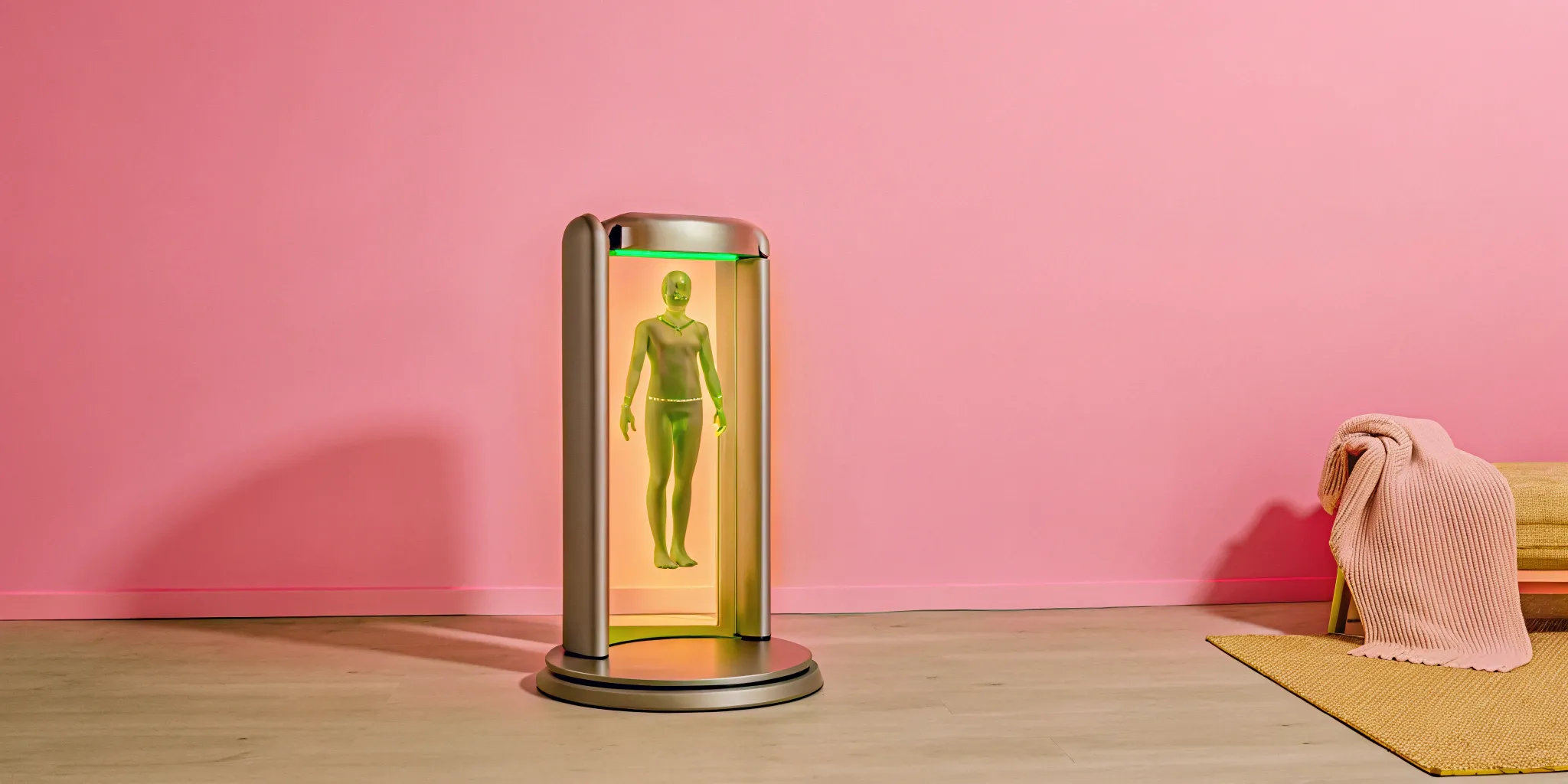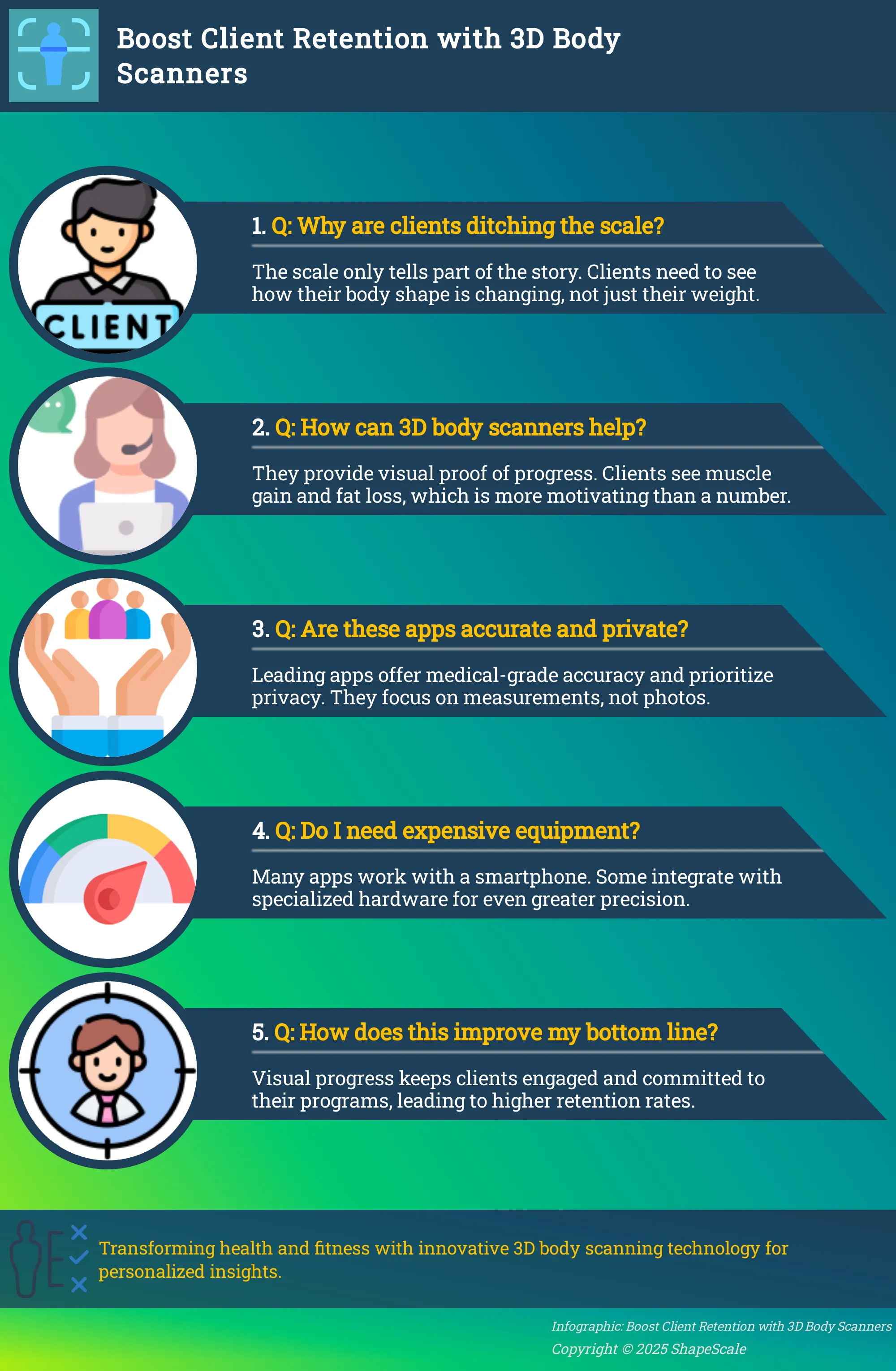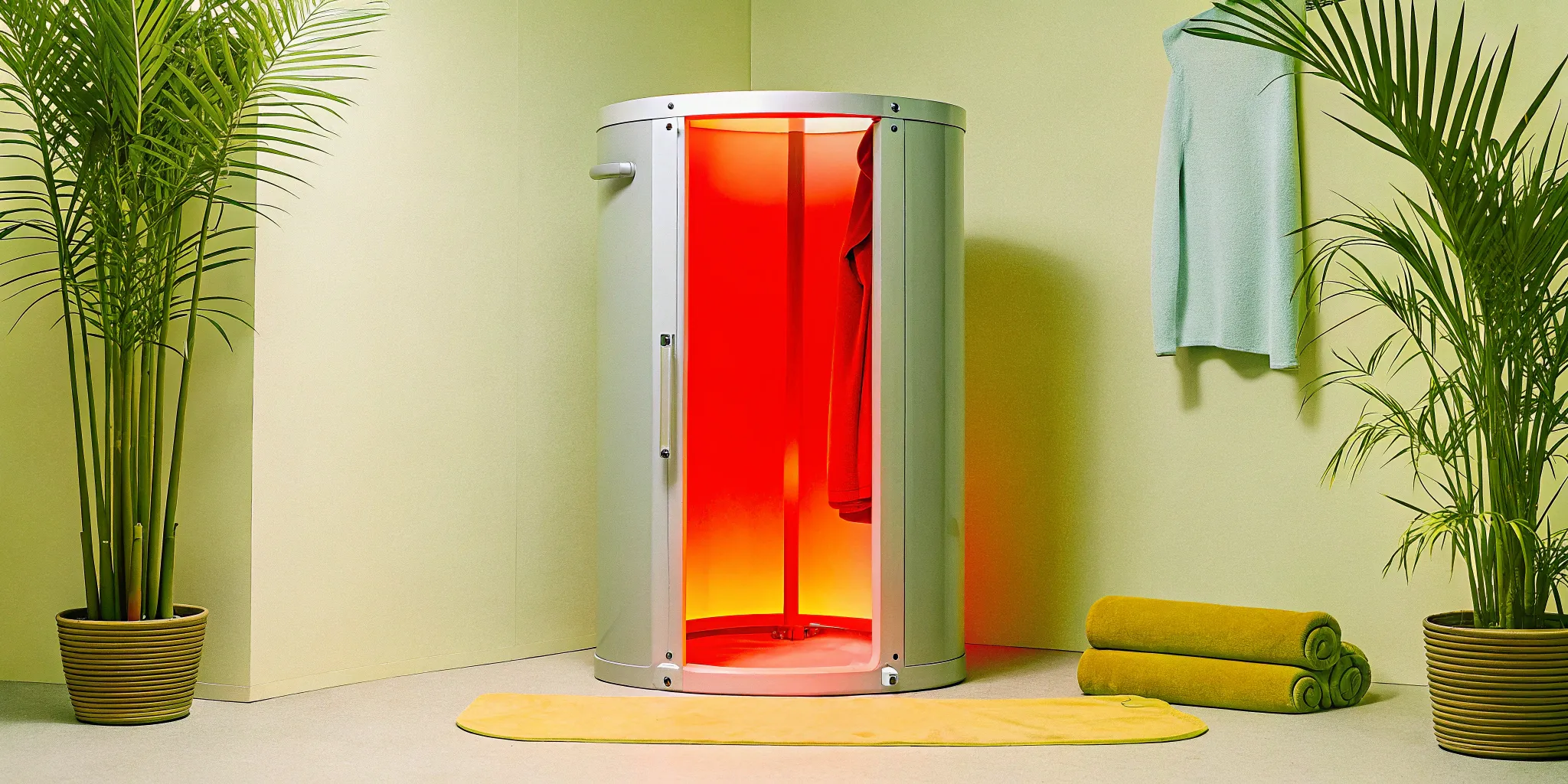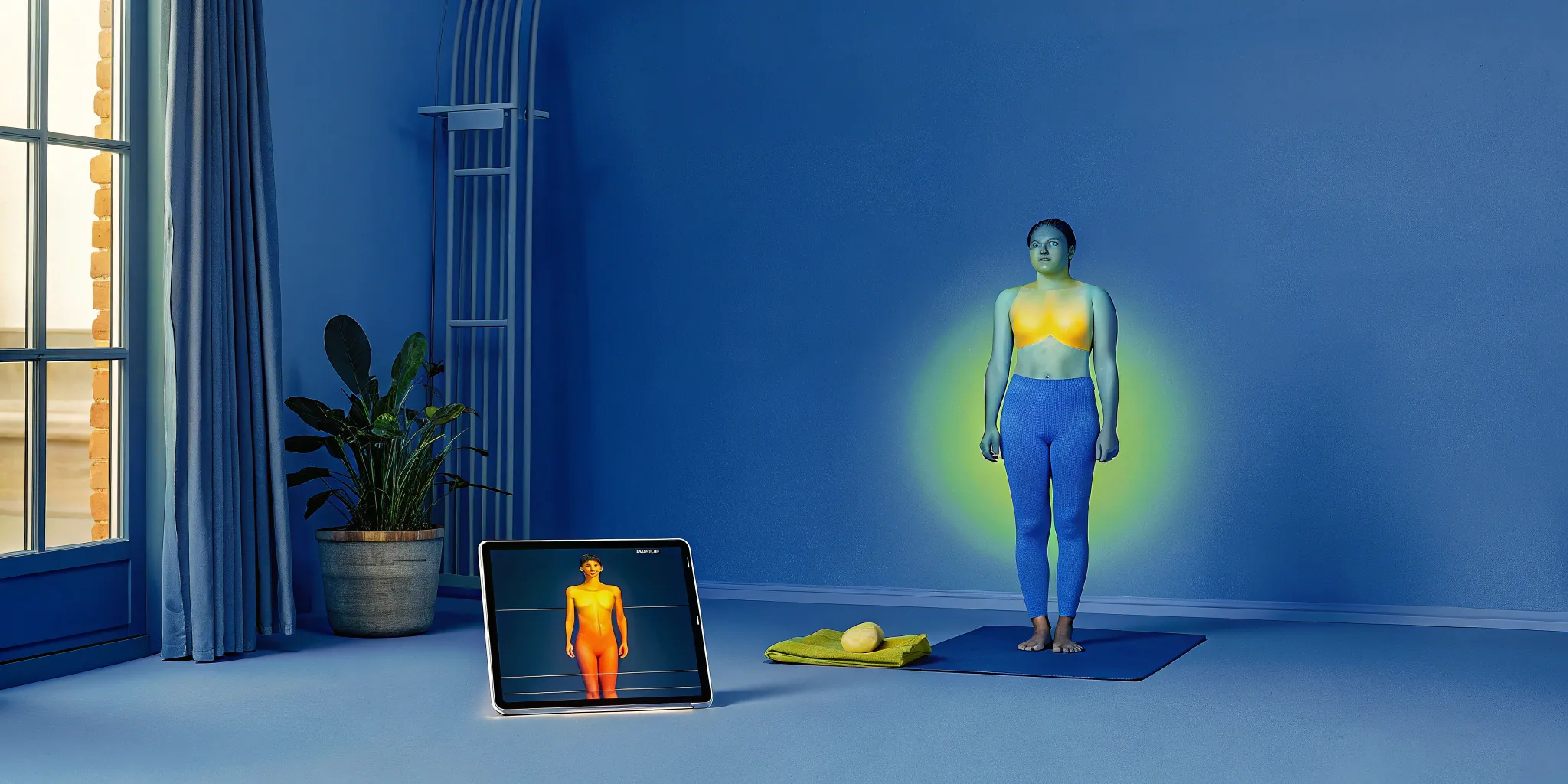5 Best 3D Body Scanner Apps for Wellness Businesses


Heading 2
Heading 1
Heading 3
Heading 4
Heading 5
Heading 6
Lorem ipsum dolor sit amet, consectetur adipiscing elit, sed do eiusmod tempor incididunt ut labore et dolore magna aliqua. Ut enim ad minim veniam, quis nostrud exercitation ullamco laboris nisi ut aliquip ex ea commodo consequat. Duis aute irure dolor in reprehenderit in voluptate velit esse cillum dolore eu fugiat nulla pariatur.
Block quote
Ordered list
- Item 1
- Item 2
- Item 3
Unordered list
- zz
- Item B
- Item C
Bold text
Emphasis
Superscript
Subscript
Client motivation is the bedrock of any successful wellness business. When progress isn't clearly visible, commitment can fade. The bathroom scale is often a poor indicator of success, failing to capture important changes in body composition that reflect a client's hard work. Visual proof is far more powerful. A 3D body scanner app provides exactly that, showing clients compelling side-by-side comparisons of their changing shape over time. This visual evidence of muscle gain and fat loss keeps them engaged and committed to their goals. To help you find the right tool for your practice, we’ve compiled a guide to the best 3d body scanner app for improving client retention.

Key Takeaways
- Show, Don't Just Tell, Progress: Use the 3D visuals from a scanner app to provide clients with clear, motivating proof of their changing body shape. This visual evidence of fat loss and muscle gain is often more impactful than scale weight and is key for client retention.
- Select for Accuracy and Simplicity: For professional use, choose an app with reliable, precise measurements to build client trust. A straightforward interface and quick scanning process are also essential to encourage regular check-ins from both staff and clients.
- Match the Technology to Your Services: Define your business's primary needs before choosing an app. A personal trainer might require detailed body composition data, while a weight management center may focus on circumference measurements, so select a tool with the right features to support your specific client goals.
What is a 3D Body Scanner App?
A 3D body scanner app uses the camera on a smartphone or tablet, sometimes paired with a rotating scale, to create a detailed, three-dimensional model of a person's body. Think of it as a high-tech, digital tape measure that captures hundreds of precise measurements in just a few seconds. Instead of relying on a simple scale that only shows total weight, these apps provide a complete picture of body shape and composition. This technology allows you and your clients to see and track changes in body fat percentage, lean mass, and key circumference measurements over time, offering a much richer story than weight alone can tell.
For wellness businesses, incorporating a 3D body scanner is a powerful way to offer clients a more sophisticated and insightful tracking experience. It moves the conversation beyond the scale, focusing instead on meaningful changes that reflect true progress. Whether you run a medical spa or a weight management center, this technology provides objective data to guide your programs and demonstrate their effectiveness. It replaces manual, often inconsistent measurements with a fast, private, and highly accurate process. This gives your business a modern edge and provides clients with clear, visual proof of their hard work, which is fundamental for long-term success and retention.
Key Benefits of Using One
The main benefit is providing clients with clear, visual motivation. When someone can see a side-by-side 3D comparison of their body from one month to the next, it’s far more impactful than seeing the number on the scale stay the same. This visual evidence of changing shape and muscle tone keeps clients engaged and committed to their goals. For personal trainers, this data is invaluable for creating truly customized fitness and nutrition plans. You can pinpoint where a client is losing fat or gaining muscle and adjust their program accordingly, proving your value and improving client retention.
The 5 Best 3D Body Scanner Apps
Choosing the right 3D body scanner app can make a significant difference in the services you offer your clients. The best apps provide accurate measurements, create clear visuals, and help you demonstrate progress in a compelling way. While many apps are designed for individual use, several stand out for their precision and features, making them suitable for a professional wellness environment. Here’s a look at five of the top options available for your business.
1. ShapeScale
ShapeScale is a premier choice for wellness businesses that require photorealistic 3D models and highly accurate body composition analysis. It functions as a complete scanning system, providing visuals and data comparable to a DXA scan. For personal trainers and weight management centers, this technology is invaluable for showing clients exactly how their body is changing over time. The visual "difference view" highlights muscle gain and fat loss, offering powerful motivation that numbers on a scale can't match. This level of detail helps you build trust and prove the value of your services, which is key for client retention.
2. KIRI Engine
KIRI Engine is recognized for its powerful photogrammetry technology, which uses multiple photos to create a detailed 3D model. This app is a strong option for businesses that need high-fidelity scans without investing in dedicated hardware beyond a smartphone. While it's a general-purpose scanning app, its precision can be applied to body modeling. This makes it a flexible tool if your wellness business has varied needs for 3D visualization. The app’s ability to capture fine details can help you create impressive before-and-after models that give clients a clear picture of their physical transformation.
3. Polycam
Polycam is a versatile and widely accessible 3D scanning app that works on both iOS and Android devices. It supports LiDAR scanning on newer iPhones, which uses lasers to create a highly accurate map of an object or space. This makes it a popular choice for a variety of applications, including body scanning. For a health club or a personal trainer just starting to integrate tech, Polycam offers an easy entry point. Its user-friendly interface allows you to quickly capture a client's form and generate a 3D model to track changes over their fitness program.
4. Bodymapp
Bodymapp is specifically designed for health and fitness tracking, making it a purpose-built tool for wellness professionals. The app guides users through a simple scanning process to capture over 20 different body metrics, including body fat percentage, chest circumference, and waist-to-hip ratio. This data-rich approach is perfect for creating personalized fitness and nutrition plans. By tracking these specific measurements, you can provide clients with detailed, objective feedback on their progress. This helps them stay motivated and focused on their goals, seeing tangible results beyond just weight.
5. ZOZOFit
ZOZOFit uses a special patterned suit and a smartphone app to create a 3D body scan. This method allows for precise body measurements and visual progress tracking from home. Users often report that its accuracy is impressive, making it a reliable tool for ongoing monitoring. For a weight management clinic, you could recommend ZOZOFit to clients for tracking their progress between in-person appointments. This helps keep them engaged with their program and provides you with consistent data to review during check-ins, creating a more connected and supportive client experience.
What to Look For in a 3D Body Scanner App
Choosing a 3D body scanner app for your wellness business is a significant decision. The right tool can transform how you engage with clients and track their progress, but the wrong one can lead to frustration and inaccurate data. To make the best choice, you need to look beyond the flashy features and focus on what truly matters for your clients and your operations. Think of it as adding a new capability to your team—it needs to be reliable, easy to work with, and effective at its job. From the precision of its measurements to the clarity of its progress reports, every detail counts. This guide will walk you through the essential features to look for, ensuring you select an app that provides real value and supports long-term client success.
Accurate Measurements and Body Composition
When you're helping clients with their health, you can't afford to guess. The foundation of any good 3D body scanner app is its accuracy. Look for an app that provides precise body measurements and body composition analysis, including body fat percentage. The best systems offer accuracy comparable to clinical standards like DXA scans, which builds immense trust with your clients. When they know the data is reliable, they're more likely to buy into your program and stick with it. This precision allows you to create truly personalized and effective wellness strategies based on solid facts, not estimations.
A Simple Interface and Scanning Process
Technology should make your life easier, not more complicated. A clunky app can be a major roadblock for both your staff and your clients. Prioritize an app with a clean, intuitive interface and a straightforward scanning process. The best 3D scanning apps guide the user through each step, making it simple to capture a high-quality scan in minutes. This ease of use is critical for encouraging regular check-ins. If the process is quick and painless, clients will be more willing to scan frequently, giving you consistent data to track their journey and celebrate their wins along the way.
Clear Progress Tracking and Visuals
The scale doesn't tell the whole story, and that's where visual progress tracking becomes a powerful tool for motivation. Your clients need to see their hard work paying off, especially when weight fluctuations might be discouraging. Look for an app that offers clear, compelling visuals, like interactive side-by-side comparisons of their 3D body models. Being able to see a direct comparison of their shape from one scan to the next can highlight changes in muscle tone and fat loss that numbers alone can't capture. This visual feedback reinforces their commitment and helps them appreciate the non-scale victories on their wellness journey.
Data Export and Integration
Your client data shouldn't be trapped in a single app. For maximum flexibility, choose a scanner app that allows for easy data export. The ability to download 3D models in common formats like OBJ or STL can be incredibly useful. This feature allows you to integrate the data with other health applications or even use it for custom reports. For businesses that work with other specialists or use multiple software platforms, this data portability is essential for creating a seamless workflow. It ensures that the valuable information you collect can be used across your entire business ecosystem, providing a more holistic view of client health.
Comparison and Reporting Features
Raw data is one thing, but actionable insights are what drive results. A top-tier 3D body scanner app will offer robust comparison and reporting features that help you and your clients understand what the numbers mean. Instead of just showing a list of measurements, the app should provide interactive reports that illustrate changes in body shape and composition over time. These detailed reports are perfect for review sessions, allowing you to pinpoint areas of progress and adjust plans accordingly. This level of analysis helps your medical spa or wellness practice stand out by offering a data-driven, highly personalized client experience.
How Do 3D Body Scanner Apps Work?
3D body scanner apps might sound like something out of a sci-fi movie, but the technology is surprisingly straightforward. At their core, these apps use your device's camera to capture your body's shape and turn it into a detailed digital model. This process gives you and your clients a wealth of information that goes far beyond the bathroom scale. Understanding how this technology works can help you explain its value to your clients and integrate it seamlessly into your wellness services. From the initial scan to the final report, each step is designed to provide clear, actionable insights into a person's fitness journey.
The Scanning Technology
Most 3D body scanner apps use a process called photogrammetry, which involves taking multiple photos from different angles and stitching them together to create a 3D model. Your smartphone's camera is the primary tool here. Some of the more advanced systems, like ShapeScale, use a patented technology that combines computer vision and machine learning for even greater precision. This technology creates a photorealistic 3D avatar of your client's body. The app guides the user through the scanning process, ensuring all the necessary images are captured correctly to build an accurate digital representation.
How Your Data is Processed and Analyzed
Once the scan is complete, the app’s algorithms get to work. They analyze the geometry of the 3D model to calculate precise body measurements and composition metrics. The accuracy of this data is what separates a helpful tool from a novelty. For example, some platforms can achieve depth accuracy down to a sixteenth of an inch, which is critical for tracking subtle changes in body fat and muscle mass. This precision allows you and your clients to see real progress, even when the scale doesn’t move. This is especially valuable for health clubs aiming to show members tangible results from their training programs.
How to Interpret Your Results
The best apps don't just give you a list of numbers; they help you visualize progress in a meaningful way. Raw data can be confusing, but seeing a side-by-side comparison of a 3D avatar from one month to the next is instantly understandable. Features like interactive 3D models and color-coded heatmaps show exactly where a client has gained muscle or lost fat. This kind of visual feedback provides insights that the naked eye would miss. It helps clients connect their efforts with the outcomes, making it a powerful motivational tool for anyone on a wellness journey. You can see how these interactive comparisons work in practice.
Compare Pricing and Value
Choosing the right 3D body scanner app involves looking at more than just features; you also need to consider the cost and the value it brings to your business. The pricing models for these apps can vary, from free versions with basic functions to professional-grade systems with recurring subscriptions. Understanding these differences will help you find a solution that fits your budget and provides a clear return on investment by improving client engagement and results.
Free vs. Paid Features
Many scanner apps use a freemium model, offering a free version with basic capabilities and a paid version with advanced tools. The free option is a great way to test the app's interface and core scanning function without a financial commitment. However, for a professional setting like a health club or wellness center, the paid features are often essential. These premium tiers typically provide more detailed metrics, unlimited scan history, and data export options—all critical for tracking client progress over time and delivering a high-quality service. Think of the free version as a trial run to ensure the app is a good fit for your workflow.
Subscriptions vs. One-Time Purchases
Most advanced body scanning apps operate on a subscription basis rather than a single upfront purchase. This model makes powerful technology more accessible, as you can avoid a large initial investment. A monthly or annual fee, which often includes regular software updates and customer support, can be easier to manage within your business's operating budget. A premium subscription might unlock detailed metrics like visceral fat and fat mass index. These data points are invaluable for personal trainers who need to provide clients with a comprehensive view of their health and progress beyond what a simple scale can show.
Is a Paid App Worth It?
For a wellness business, investing in a high-quality, paid scanning solution is almost always worth it. The value comes from the accuracy, reliability, and client experience it provides. Professional-grade systems offer body composition measurements with accuracy comparable to a DXA scan, giving you and your clients confidence in the data. This level of precision is crucial for medical spas and weight management clinics. More importantly, seeing visual changes in a 3D model is incredibly motivating for clients. When they can see their shape changing, they are more likely to stay committed to their program, which directly translates to better retention for your business.
Common Experiences and Challenges
While 3D body scanner apps offer incredible benefits, it helps to know about common user experiences and potential hurdles. Some apps deliver exceptional accuracy, while others can be frustrating. Understanding these differences helps you select the right technology for your business and guide your clients effectively. Setting clear expectations ensures the scanning process is a positive and motivating part of their wellness program.
Pros and Cons of the Top Apps
Client feedback on the best 3D scanner apps is often positive, with many users finding the technology highly motivating. For instance, ShapeScale is frequently praised for its precision, with users noting its body fat percentage measurements are comparable to medical-grade DXA scans. One user called it "hands down the best device that I've tried for tracking how my body is changing." Similarly, apps like ZOZOFIT impress users with their accuracy, with some saying a scan is just as accurate as a professional scanner at their gym. The main drawback is inconsistency; while top-tier apps are reliable, many others lack the polish your clients will expect.
How to Handle Scanning Issues
Not all 3D scanning apps are created equal, and some users report buggy or difficult scanning processes. As some developers have noted, easy-to-use and consistently accurate 3D body scan apps are still not the norm, especially among free options. To prevent frustration, choose a professional-grade platform known for reliability. You can also help clients succeed by providing a dedicated, well-lit space for scans and offering clear instructions. Guiding them through their first scan can turn a potentially tricky process into a smooth and empowering one.
What About Privacy and Data Security?
Clients are right to be concerned about the privacy of their body data. It's a sensitive topic, and building trust is key. Fortunately, leading apps are designed with security in mind. Many platforms address this by scanning a body's outline rather than capturing a photorealistic image. For example, some apps explicitly state they don't upload your photos to the internet, processing data on the device itself. This focus on measurements over images also helps keep clients motivated by showing them tangible changes in their body shape. When choosing an app, review its privacy policy so you can confidently answer any client questions.
How to Choose the Right App for You
Selecting the right 3D body scanner app is a key decision for your business and your clients. The best app for you will depend on your specific business goals, the devices you use, and the level of support you need. By thinking through a few key areas, you can find a solution that fits seamlessly into your workflow and helps your clients see the results of their hard work.
Define Your Personal Needs
First, get clear on what you want the app to do. Are you a personal trainer focused on showing muscle gain and fat loss? Or do you run a weight management center where tracking circumference measurements is key? Different apps excel at different things. Some are built for general fitness tracking, while others offer detailed analytics. Consider if you need to export the data for other programs or simply want a powerful visual tool to motivate clients. Listing your top three "must-have" features will help you quickly filter out apps that aren't a good fit for your business and its unique client goals.
Check Device Compatibility
This might seem obvious, but it's a critical step. Before you get attached to an app's features, confirm it works with the devices you and your clients use, whether that's iOS or Android. Some apps require newer phones with specific hardware, like a LiDAR sensor, to create accurate scans. A mismatch here can lead to a frustrating experience for everyone. Check the app’s requirements on its store page before you download. This simple check ensures a smooth scanning process from the start and prevents you from investing time in a tool that won't work for your setup.
Review App Support and Updates
An app is only as good as the team behind it. Look for apps that are updated regularly—this shows the developers are actively fixing bugs and improving features. For a business tool, reliable customer support is also essential. What happens if you run into an issue during a client session? You'll want a responsive support team. Many apps offer free trials, which are great for testing functionality. For business use, a paid plan often provides better support and more advanced features. You can often get a feel for the company's reliability by reading reviews and seeing how they support their clients.
Frequently Asked Questions
How accurate are these 3D body scanner apps compared to traditional methods? The accuracy really depends on the app you choose. While many free or consumer-grade apps provide a good general idea of body shape, professional systems are in a different league. Top-tier platforms like ShapeScale are engineered for precision and deliver body composition metrics with accuracy that is comparable to a clinical DXA scan. This level of reliability is what builds trust with clients and allows you to create truly effective, data-driven wellness plans.
Will my clients feel comfortable using a 3D scanner, and is their data private? This is a valid concern, and the best app developers have addressed it directly. The scanning process is designed to be quick, private, and straightforward. To protect privacy, many professional apps focus on capturing the body's geometry and measurements rather than identifiable, photorealistic images. Some even process data directly on the device instead of uploading it to the cloud. By choosing a reputable app and explaining the privacy measures to your clients, you can make the experience feel secure and empowering.
Is it really necessary to invest in a paid app, or can my business get by with a free one? While a free app can be a good way to familiarize yourself with the technology, a professional wellness business needs the reliability and advanced features that come with a paid subscription. Paid apps typically offer greater accuracy, detailed progress reports, data export options, and dedicated customer support. This investment ensures you have a dependable tool that provides real value, helping you track client outcomes effectively and justify the quality of your services.
Do I need to buy special hardware for my business to use a 3D body scanner app? Not always, but it often helps. Many apps can function using just a smartphone camera, which makes them very accessible. However, for the highest level of precision, some systems incorporate dedicated hardware. For example, ShapeScale uses a patented rotating scale that works with the app to create photorealistic 3D models and extremely accurate measurements. For a business that stakes its reputation on results, investing in a complete system provides a more consistent and professional experience.
How exactly does showing clients a 3D model of themselves help with retention? It shifts the focus from the scale to tangible changes in body composition. A client might not lose weight in a month, but a 3D scan can show they’ve lost inches from their waist and gained muscle in their arms. This visual proof is incredibly motivating because it validates their hard work in a way numbers on a scale cannot. When clients can clearly see their body transforming, they stay engaged, feel successful, and remain committed to your program long-term.




